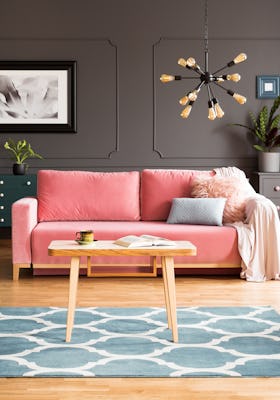(Home)
If You Insist On This Hard-To-Pull-Off Wall Color, Here's How To Do It Like The Pros
Give the suggestions ahead a quick glance.

Paint color is one of the biggest decisions you can make when it comes to redecorating your space — after all, it's kind of a pain to re-do once you've put forth the manual labor, and it takes up quite a big of real estate in a room — so it's not surprising that you could be swatching for weeks before finally settling on the perfect shade. That said, according to decor experts there are a few wall colors to avoid, and knowing which ones those are (or a way to make them work if you're already committed) can make the decision a whole lot easier.
First of all, it probably goes without saying that there shouldn't be any hard and fast rules when it comes to decor: If you love it, you should do it. However, it can be easy to get caught up in things like paint trends or images you see on social media that could sway you into a palette that's just extremely tough to pull off in your space — especially if you don't have some helpful tips from top interior designers.
For the most part, people fall into one of two categories: Those who stick to subtle neutrals for a safe bet, and those who think "the bolder the better" — and neither type is wrong. If you tend to be in the former, Jade Joyner, Co-Founder and Principal Designer of Metal + Petal suggests a warm white that can go with practically any decor. "I prefer a bright, neutral palette, and am currently obsessed with Chantilly Lace by Benjamin Moore," she says. "It's a pretty white that isn't cold or sterile feeling like other variations of the hue."
As far as those to steer clear of? While both Joyner and Nancy Charbonneau of Charbonneau Interiors think there's a way to pull off practically any color — such as limiting it to an accent wall and/or using it in combination with those that are more neutral — there are certainly a few standouts on the "notoriously difficult" list. So before you start shopping for the new shade of your bedroom or living room, give the suggestions ahead a quick glance.
Grey
Although grey is technically a neutral tone, Joyner admits it can be trickier than you'd think. According to her, the undertones can make it or break it. "Often greys will look perfect on the swatch, and, depending on the light and shadows, will turn purple or blue once it's on the wall," she explains. "My advice for finding a true grey is to try out several shades in the space, and then see how it looks with the light in your home." One she can cosign for? Agreeable Gray, a sort-of "greige" which she says isn't overpowering.
Black
When it comes to your wardrobe, you can never have enough black. But as Joyner explains, the same can't be said for the color in your home — particularly if it's a small space without a lot of natural light. "Black can be too severe, so sometimes a smokey grey or dark charcoal is a better choice," she says. "Again, it's important to try it in your space before you buy it and apply it to all the walls." And if you're determined to have it on your walls, pick a room that gets a good amount of light, and limit it so a smaller accent wall to start.
Pink
"I think it's really difficult to pick the perfect pink because a lot of pinks read more saturated on an actual wall than in a paint deck," explains Charbonneau. "Natural light and artificial light impact pink more than a lot of other colors, in my opinion, and I find that it's usually pretty sensitive to light in particular. I'm working on a project right now where we're painting some walls pink, and the color on the deck we initially picked is so beautiful — but on the wall, it was totally not what we were looking for." That said, be sure you swatch directly on your wall and examine it in different lighting before totally committing to the color.
Yellow
"Yellow is also hard to get right every single time" says Charbonneau, although she admits that sometimes an intense brightness might be just the effect you're after. "If you're going for an electric look, the yellows in the color deck are perfect. But if you're looking for a softer, sunnier shade, you probably won't be able to do so right from a paint deck."
This article was originally published on